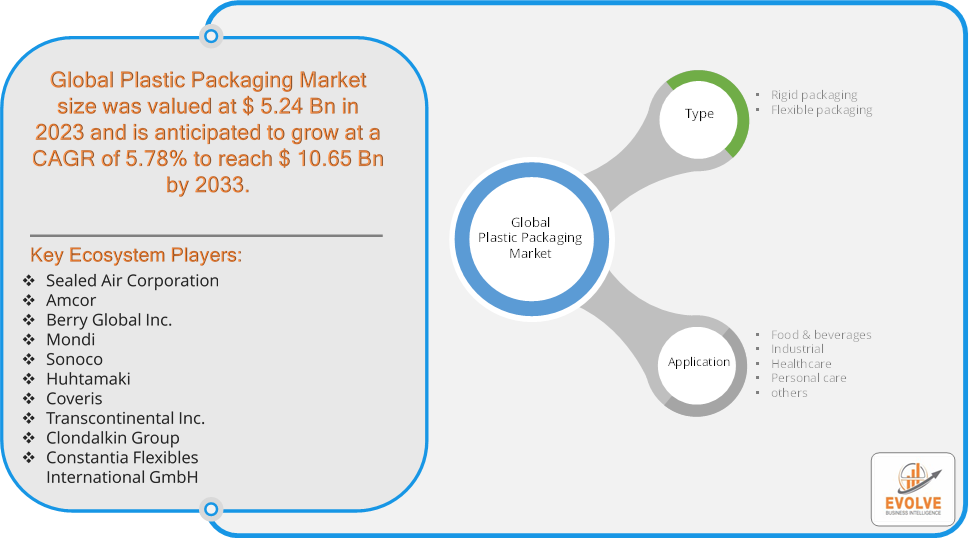Evolve Business Intelligence has published a research report on the Global Plastic Packaging Market, 2023–2033. The global Plastic Packaging Market is projected to exhibit a CAGR of around 5.78% during the forecast period of 2023 to 2033.
Evolve Business Intelligence has recognized the following companies as the key players in the global Plastic Packaging Market: Sealed Air Corporation, Amcor, Berry Global Inc., Mondi, Sonoco, Huhtamaki, Coveris, Transcontinental Inc., Clondalkin Group and Constantia Flexibles International GmbH.
 More Information: https://evolvebi.com/report/plastic-packaging-market-analysis/
More Information: https://evolvebi.com/report/plastic-packaging-market-analysis/
Market Highlights
The Global Plastic Packaging Market is projected to be valued at USD 10.65 Billion by 2033, recording a CAGR of around 5.78% during the forecast period. The Plastic Packaging Market refers to the industry involved in the production, distribution, and sale of packaging materials made from various types of plastic. This market includes a wide range of products such as bottles, containers, bags, films, wraps, and pouches, which are used to protect, preserve, and transport goods in multiple industries including food and beverages, pharmaceuticals, personal care, consumer goods, and industrial applications.
The Plastic Packaging Market is a large and diverse sector that plays a crucial role in global trade and consumer goods distribution. The growing environmental concerns surrounding plastic waste have led to increased scrutiny of the plastic packaging industry. Efforts are being made to develop sustainable and recyclable plastic packaging solutions, as well as to promote proper waste management practices.
The COVID-19 pandemic had a significant impact on the Plastic Packaging Market. The demand for plastic packaging surged in the healthcare sector due to the need for medical supplies, personal protective equipment (PPE), and pharmaceutical products. Plastic packaging was essential for safely transporting and storing these items. With the rise in online grocery shopping, takeaway services, and home delivery, there was an increased demand for plastic packaging, particularly for food safety and hygiene. Single-use plastic packaging became more prevalent due to concerns about contamination. Consumers prioritized hygiene, leading to a preference for products with secure and tamper-evident packaging. This bolstered the use of plastic packaging, which is often perceived as safer and more hygienic. The pandemic caused disruptions in the supply chain, leading to shortages of raw materials like resin, which is used to produce plastic. This affected the manufacturing and supply of plastic packaging. Post-pandemic, there has been a renewed focus on sustainability in the plastic packaging industry, with companies and consumers seeking more environmentally friendly options.
Segmental Analysis
The global Plastic Packaging Market has been segmented based on Type and Application.
Based on Type, the Plastic Packaging Market is segmented into Rigid packaging and Flexible packaging. The Flexible packaging segment is anticipated to dominate the market.
Based on Application, the global Plastic Packaging Market has been divided into Food & beverages, Industrial, Healthcare, Personal care and others. The Food & beverages segment is anticipated to dominate the market.
More Information: https://evolvebi.com/report/plastic-packaging-market-analysis/
Regional Analysis
The Plastic Packaging Market is divided into five regions: North America, Europe, Asia-Pacific, South America, and the Middle East, & Africa. North America is a mature market for plastic packaging, with established industries in food and beverages, healthcare, and consumer goods driving demand. There is a strong emphasis on sustainability in this region, with consumers and regulators pushing for increased use of recycled and biodegradable plastics. Companies are investing in green packaging solutions to meet these demands. Europe is a global leader in sustainable packaging practices, driven by the European Union’s strict environmental regulations and strong consumer demand for eco-friendly products. The region is heavily focused on circular economy initiatives, with significant investments in recycling infrastructure and the development of reusable packaging systems. The Asia-Pacific region, particularly countries like China, India, and Southeast Asia, is experiencing rapid industrialization and urbanization, leading to increased demand for plastic packaging across various industries. The rising middle class and changing consumer lifestyles are driving the demand for packaged foods, beverages, personal care products, and pharmaceuticals, boosting the plastic packaging market. Latin America represents an emerging market for plastic packaging, with growth driven by the food and beverage industry, personal care products, and increasing urbanization. Countries like Brazil, Mexico, and Argentina are seeing increased investments in packaging technologies and materials, providing opportunities for growth in both traditional and sustainable plastic packaging. The Middle East and Africa are developing markets with growing demand for plastic packaging, particularly in the food and beverage, healthcare, and consumer goods sectors. The region faces significant environmental challenges, including plastic waste management. However, there is a gradual shift towards adopting more sustainable packaging practices, influenced by global trends and local government initiatives.